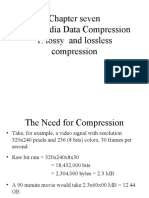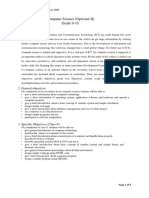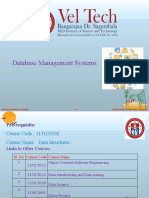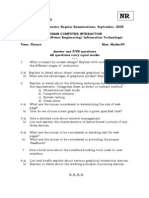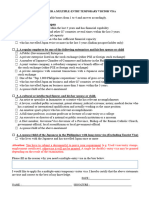0 ratings0% found this document useful (0 votes)
460 viewsForces Behind E-Com
The document discusses the various forces driving e-commerce adoption by organizations. It identifies key market, economic, technological, and societal factors that are creating pressures on businesses and forcing them to respond through innovative activities and continuous improvement efforts. Specifically, it notes how economic factors like lower costs, new sales opportunities, and internal/external integration are encouraging e-commerce use. Organizations are responding through strategic systems, continuous improvement, business process reengineering, and alliances to address these pressures and take advantage of opportunities in the changing business environment.
Uploaded by
Sparsh GuptaCopyright
© © All Rights Reserved
Available Formats
Download as DOCX, PDF, TXT or read online on Scribd
0 ratings0% found this document useful (0 votes)
460 viewsForces Behind E-Com
The document discusses the various forces driving e-commerce adoption by organizations. It identifies key market, economic, technological, and societal factors that are creating pressures on businesses and forcing them to respond through innovative activities and continuous improvement efforts. Specifically, it notes how economic factors like lower costs, new sales opportunities, and internal/external integration are encouraging e-commerce use. Organizations are responding through strategic systems, continuous improvement, business process reengineering, and alliances to address these pressures and take advantage of opportunities in the changing business environment.
Uploaded by
Sparsh GuptaCopyright
© © All Rights Reserved
Available Formats
Download as DOCX, PDF, TXT or read online on Scribd
You are on page 1/ 4
Forces Behind E-commerce
E-Commerce is becoming popular, it is worthwhile to examine today’s business environment so
let us understand the pressures it creates on organizations and the responses used by
organizations.
Environmental factors that create Business Pressures:
Market, economical, societal and technological factors are creating a highly competitive business
environment in which consumers are the focal point. These factors change quickly, sometimes in
an unpredictable manner and therefore companies need to react frequently not only in the
traditional actions such as lowering cost and closing unprofitable facilities but also innovative
activities such as customizing products, creating new products or providing superb customer
service.
Economic Forces One of the most evident benefits of e-commerce is economic efficiency
resulting from the reduction in communications costs, low-cost technological
infrastructure,speedier and more economic electronic transactions with suppliers,lower global
information sharing and advertising costs,and cheaper customer service alternatives.
Categories of Economic Forces
Lower marketing costs: marketing on the Internet maybe cheaper and can reach a wider
crowd than the normal marketing medium.
Lower sales costs: increase in the customer volume do not need an increase in staff as the sales
function is housed in the computer and has virtually unlimited accessibility
Lower ordering processing cost: online ordering can be automated with checks to ensure that
orders are correct before accepting, thus reducing errors and the cost of correcting them.
New sales opportunities: the website is accessible all the time and reaches the global audience
which is not possible with traditional store front.
Economic integration is either external or internal. External integration refers to the electronic
networking of corporations, suppliers, customers/clients, and independent contractors into one
community communicating in a virtual environment (with the Internet as medium). Internal
integration, on the other hand, is the networking of the various departments within a corporation,
and of business operations and processes. This allows critical business information to be stored
in a digital form that can be retrieved instantly and transmitted electronically. Internal integration
is best exemplified by corporate intranets.
Among the companies with efficient corporate intranets are Procter and Gamble, IBM, Nestle
and Intel. EG. SESAMi.NET: Linking Asian Markets through B2B Hubs SESAMi.NET is
Asia’s largest B2B e-hub, a virtual exchange integrating and connecting businesses (small,
medium or large) to trading partners, e-marketplaces and internal enterprise systems for the
purpose of sourcing out supplies, buying and selling goods and services online in real time. The
e-hub serves as the centre for management of content and the processing of business transactions
with support services such as financial clearance and information services.
It is strategically and dynamically linked to the Global Trading Web (GTW), the world’s largest
network of trading communities on the Internet. Because of this very important link, SESAMi
reaches an extensive network of regional, vertical and industry-specific interoperable B2B e-
markets across the globe.
Market Forces
Corporations are encouraged to use e-commerce in marketing and promotion to capture
international markets, both big and small. The Internet is likewise used as a medium for
enhanced customer service and support. It is a lot easier for companies to provide their target
consumers with more detailed product and service information using the Internet. Strong
competition between organizations, extremely low labor cost in some countries, frequent and
significant changes in markets and increased power of consumers are the reasons to create
market forces.
Technology Forces
The development of information and communications technology (ICT) is a key factor in the
growth of ecommerce. For instance, technological advances in digitizing content, compression
and the promotion of open systems technology have paved the way for the convergence of
communication services into one single platform. This in turn has made communication more
efficient, faster, easier, and more economical as the need to set up separate networks for
telephone services, television broadcast, cable television, and Internet access is eliminated. From
the standpoint of firms/ businesses and consumers, having only one information provider means
lower communications costs.
Moreover, the principle of universal access can be made more achievable with convergence. At
present the high costs of installing landlines in sparsely populated rural areas is incentive to
telecommunications companies to install telephones in these areas. Installing landlines in rural
areas can become more attractive to the private sector if revenues from these landlines are not
limited to local and long distance telephone charges, but also include cable TV and Internet
charges. This development will ensure affordable access to information even by those in rural
areas and will spare the government the trouble and cost of installing expensive landlines
Societal and environmental forces
To understand the role of E-commerce in today’s organizations, it becomes necessary to review
the factors that create societal and environmental forces.
Changing nature of workforce
Government deregulations
Shrinking government subsidies
Increased importance of ethical and legal issues
Increased social responsibility of organizations
Rapid political changes
Critical response activities by Organizations
A response can be a reaction to a pressure already in existence, or it can be an initiative that will
defend an organization against future pressures. It can also be an activity that exploits an
opportunity created by changing conditions.
Organizations’ major responses are divided into five categories:strategic systems for competitive
advantage,continuous improvement efforts, business process reengineering (BPR), business
alliances and EC.These several responses can be interrelated and Ecommerce can also facilitate
the other categories. The four categories are described below.
Strategic Systems
Strategic systems provide organizations with strategic advantages, thus enabling them to increase
their market share, better negotiate with their suppliers, or prevent competitors from entering into
their territory. There is a variety of EC supported strategic systems. An example is FedEx’s
overnight delivery system and the company’s ability to track the status of every individual
package anywhere in the system. Most of FedEx’s competitors have already mimicked the
system. So FedEx moved the system to the Internet. However, the competitors quickly followed
and now FedEx is introducing new activities.
Continuous Improvement Efforts
In order to improve the company’s productivity and quality, many companies continuously
conduct innovative programs. The efforts taken by companies for continuous improvement are
Improved productivity
Improved decision making
Managing Information
Change in management
Customer service Innovation and
Creativity.
For example, Dell Computer takes its orders electronically and improved moves them via
Enterprise Resources Planning software (from SAP Corp.) into the just-in-time assembly
operation. Intel is taking its products’ consumption in 11 of its largest customers, using its
extranets, almost in real time, and determining production schedules and deliveries accordingly.
Business Process Reengineering (BPR)
Business Process Reengineering refers to a major innovation in the organization’s structure and
the way it conducts business. Information technology and especially EC play a major role in
BPR. Electronic Commerce provides flexibility in manufacturing, permits faster delivery to
customers and supports rapid and paperless transactions among suppliers, manufacturers and
retailers.
The major areas in which E-Commerce supports BPR are
Reducing cycle time and time to market: Reducing the business process time (cycle time) is
extremely important for increasing productivity and competitiveness.Similarly, reducing the
time from the inception of an idea until its implementation— time to market—is important
because those who can be first on the market with a product, or who can provide customers
with a service faster than competitors, enjoy a distinct competitive advantage.
Empowerment of employees and collaborative work: Empowerment is related to the
concept of self-directed teams. Management delegates authority to teams who can execute the
work faster and with fewer delays. Information Technology allows the decentralization of
decision making and authority but simultaneously supports a centralized control. For example,
the Internet and the intranets enable empowered employees to access data, information and
knowledge they need for making quick decisions.
Knowledge management: Employees can access organizational know-how via their
company’s intranet. Some knowledge bases are open to the public for a fee over the Internet,
generating income.
Customer-focused approach: Companies are becoming increasingly customer oriented. This
can be done in part by changing manufacturing processes from mass production to mass
customization. In mass production, a company produces a large quantity of identical items. In
mass customization, items are produced in a large quantity but are customized to fit the desires
of each customer. Electronic commerce is an ideal facilitator of mass customization.
Business alliances
Many companies realize that alliances with other companies, even competitors can be beneficial.
There are several types of alliances, such as sharing resources, establishing permanent supplier-
company relationships and creating joint research efforts. One of the most interesting types is the
temporary joint venture, in which companies form a special organization for a specific, limited-
time mission.
E-Commerce Communities
What it is that will drive e-commerce in the future? — in a word, it’s community.
We certainly have the technology to build great business-to-consumer and business-to business
ecommerce applications into our business models. And, yes, attributes such as viable application
design, integration with business processes, and overall performance matter.
A successful community strategy must embrace the idea of moving the one-onone
communication that occurs offline into the virtual world of e-commerce. Such a strategy
currently requires multiple technical approaches. However, we believe community solutions will
soon become more integrated and far-reaching.
The tools that form online communities include discussion or forum software, chat functions,
instant messaging, two-way mailing lists, online collaboration tools, audio, video, and more. You
may choose to invest slowly at first and increase your community commitment over time.
Online conversation with business partners will also give net positive results. A private
discussion area or secured online meetings can go a long way toward building stronger
relationships between companies. This will also serve to potentially drive new business
opportunities for both parties. Building community has to be at the heart of any successful
ecommerce strategy.
Is e-Commerce the Same as e-Business?
While some use e-commerce and e-business interchangeably, they are distinct concepts. In e-
commerce, information and communications technology (ICT) is used in inter-business or inter-
organizational transactions (transactions between and among firms/ organizations) and in
business-to-consumer transactions (transactions between firms/ organizations and individuals).
In e-business, on the other hand, ICT is used to enhance one’s business. It includes any process
that a business organization (either a for-profit, governmental or non-profit entity) conducts over
a computer-mediated network. A more comprehensive definition of e-business is: “The
transformation of an organization’s processes to deliver additional customer value through the
application of technologies, philosophies and computing paradigm of the new economy.”
Three primary processes are enhanced in e-business:
1. Production processes, which include procurement, ordering and replenishment of stocks;
processing of payments; electronic links with suppliers; and production control processes, among
others;
2. Customer-focused processes, which include promotional and marketing efforts, selling over
the Internet, processing of customers’ purchase orders and payments, and customer support,
among others; and
3. Internal management processes, which include employee services, training, internal
information-sharing, videoconferencing, and recruiting. Electronic applications enhance
information flow between production and sales forces to improve sales force productivity.
Workgroup communications and electronic publishing of internal business information are
likewise made more efficient. The Internet economy pertains to all economic activities using
electronic networks as a medium for commerce or those activities involved in both building the
networks linked to the Internet and the purchase of application services such as the provision of
enabling hardware and software and network equipment for Web-based/online retail and
shopping malls (or “e-malls”).
You might also like
- Northeastern University Department of Economics100% (4)Northeastern University Department of Economics3 pages
- 2023 LECTURE 1 NATURE, SOURCE and PURPOSE OF MANAGEMENT INFORMATION100% (1)2023 LECTURE 1 NATURE, SOURCE and PURPOSE OF MANAGEMENT INFORMATION63 pages
- A Brief History of Chatbots: Destech Transactions On Computer Science and Engineering October 2019No ratings yetA Brief History of Chatbots: Destech Transactions On Computer Science and Engineering October 20196 pages
- Different Networking Devices: Passive Hub Active HubNo ratings yetDifferent Networking Devices: Passive Hub Active Hub9 pages
- Chapter Seven Multimedia Data Compression 1. Lossy and Lossless Compression100% (1)Chapter Seven Multimedia Data Compression 1. Lossy and Lossless Compression34 pages
- DBMS Unit-1 PPT 1.1 (Introduction, Drawback of File Sysstem, View of Data)No ratings yetDBMS Unit-1 PPT 1.1 (Introduction, Drawback of File Sysstem, View of Data)4 pages
- Installation Procedure: - Install Android StudioNo ratings yetInstallation Procedure: - Install Android Studio3 pages
- Computer Science (Optional II) Grade 9-10: Micro Syllabus - Academic Year 2069No ratings yetComputer Science (Optional II) Grade 9-10: Micro Syllabus - Academic Year 20696 pages
- Computer Science Textbook Solutions - 13No ratings yetComputer Science Textbook Solutions - 1330 pages
- 2-4 Steps in Developing Application:: Visual BasicNo ratings yet2-4 Steps in Developing Application:: Visual Basic12 pages
- Data Communication and Computer Network ITec2102 Model Exam QuestionsNo ratings yetData Communication and Computer Network ITec2102 Model Exam Questions3 pages
- Database Management Systems: ©silberschatz, Korth and Sudarshan 1.1 Database System ConceptsNo ratings yetDatabase Management Systems: ©silberschatz, Korth and Sudarshan 1.1 Database System Concepts33 pages
- Ex No: 1 Date: Program On Saas To Create Word DocumentNo ratings yetEx No: 1 Date: Program On Saas To Create Word Document18 pages
- Department of Information Technology: Question Bank Department: IT Semester: II Class:-BE Subject:-Ubiquitous ComputingNo ratings yetDepartment of Information Technology: Question Bank Department: IT Semester: II Class:-BE Subject:-Ubiquitous Computing4 pages
- Assignment Questions - Internet TechnologyNo ratings yetAssignment Questions - Internet Technology2 pages
- Course Outline - Organisational Study of IS - 2021-2022No ratings yetCourse Outline - Organisational Study of IS - 2021-20227 pages
- Q.No Aim/Principle/ Apparatus Required/procedure Tabulation/Circuit/ Program/Drawing Calculation & Results Viva-Voce Record Total 1 5 25 10 10 10 100 2 5 25 10 Q.NO. Experiment List67% (3)Q.No Aim/Principle/ Apparatus Required/procedure Tabulation/Circuit/ Program/Drawing Calculation & Results Viva-Voce Record Total 1 5 25 10 10 10 100 2 5 25 10 Q.NO. Experiment List5 pages
- Department of Computing: Lab 07: Express JSNo ratings yetDepartment of Computing: Lab 07: Express JS5 pages
- Equity of Cybersecurity in the Education System: High Schools, Undergraduate, Graduate and Post-Graduate Studies.From EverandEquity of Cybersecurity in the Education System: High Schools, Undergraduate, Graduate and Post-Graduate Studies.No ratings yet
- MERCEDES - Supplier Quality Assurance Manual (SQAM)No ratings yetMERCEDES - Supplier Quality Assurance Manual (SQAM)63 pages
- Employment Agreement For Technical EmployeeNo ratings yetEmployment Agreement For Technical Employee6 pages
- Saif Powertec Limited Project "Standard Operating Process" As-Is DocumentNo ratings yetSaif Powertec Limited Project "Standard Operating Process" As-Is Document7 pages
- DV The Advertisers Guide To 2024 ElectionsNo ratings yetDV The Advertisers Guide To 2024 Elections16 pages
- Financial Reporting (FR) Solution Pack: Sr. No. ACCA Exam Paper Syllabus Area Covered100% (1)Financial Reporting (FR) Solution Pack: Sr. No. ACCA Exam Paper Syllabus Area Covered66 pages
- Rural Businesses Case Study AcceleratorNo ratings yetRural Businesses Case Study Accelerator18 pages
- Santa Rosa Campus City of Santa Rosa, Laguna: Polytechnic University of The Philippines100% (1)Santa Rosa Campus City of Santa Rosa, Laguna: Polytechnic University of The Philippines19 pages
- Interaction Design and HCI in The Software ProcessNo ratings yetInteraction Design and HCI in The Software Process46 pages
- 7.. CIS-GMCTA + Barclays UK,USA, JP, SMBCJPJT 223 0160350, PayoneerNo ratings yet7.. CIS-GMCTA + Barclays UK,USA, JP, SMBCJPJT 223 0160350, Payoneer31 pages
- Unit4 - 488 - Assignment 1 Frontsheet (Group)No ratings yetUnit4 - 488 - Assignment 1 Frontsheet (Group)8 pages
- Let's Check: To Eliminate Unrealized Gain On Sale of LandNo ratings yetLet's Check: To Eliminate Unrealized Gain On Sale of Land4 pages
- Assignment ON: School of Nursing Sciences and Research Sharda UniversityNo ratings yetAssignment ON: School of Nursing Sciences and Research Sharda University10 pages
- 2023 LECTURE 1 NATURE, SOURCE and PURPOSE OF MANAGEMENT INFORMATION2023 LECTURE 1 NATURE, SOURCE and PURPOSE OF MANAGEMENT INFORMATION
- A Brief History of Chatbots: Destech Transactions On Computer Science and Engineering October 2019A Brief History of Chatbots: Destech Transactions On Computer Science and Engineering October 2019
- Different Networking Devices: Passive Hub Active HubDifferent Networking Devices: Passive Hub Active Hub
- Chapter Seven Multimedia Data Compression 1. Lossy and Lossless CompressionChapter Seven Multimedia Data Compression 1. Lossy and Lossless Compression
- DBMS Unit-1 PPT 1.1 (Introduction, Drawback of File Sysstem, View of Data)DBMS Unit-1 PPT 1.1 (Introduction, Drawback of File Sysstem, View of Data)
- Computer Science (Optional II) Grade 9-10: Micro Syllabus - Academic Year 2069Computer Science (Optional II) Grade 9-10: Micro Syllabus - Academic Year 2069
- 2-4 Steps in Developing Application:: Visual Basic2-4 Steps in Developing Application:: Visual Basic
- Data Communication and Computer Network ITec2102 Model Exam QuestionsData Communication and Computer Network ITec2102 Model Exam Questions
- Database Management Systems: ©silberschatz, Korth and Sudarshan 1.1 Database System ConceptsDatabase Management Systems: ©silberschatz, Korth and Sudarshan 1.1 Database System Concepts
- Ex No: 1 Date: Program On Saas To Create Word DocumentEx No: 1 Date: Program On Saas To Create Word Document
- Department of Information Technology: Question Bank Department: IT Semester: II Class:-BE Subject:-Ubiquitous ComputingDepartment of Information Technology: Question Bank Department: IT Semester: II Class:-BE Subject:-Ubiquitous Computing
- Course Outline - Organisational Study of IS - 2021-2022Course Outline - Organisational Study of IS - 2021-2022
- Q.No Aim/Principle/ Apparatus Required/procedure Tabulation/Circuit/ Program/Drawing Calculation & Results Viva-Voce Record Total 1 5 25 10 10 10 100 2 5 25 10 Q.NO. Experiment ListQ.No Aim/Principle/ Apparatus Required/procedure Tabulation/Circuit/ Program/Drawing Calculation & Results Viva-Voce Record Total 1 5 25 10 10 10 100 2 5 25 10 Q.NO. Experiment List
- Introduction to Linux: Installation and ProgrammingFrom EverandIntroduction to Linux: Installation and Programming
- Equity of Cybersecurity in the Education System: High Schools, Undergraduate, Graduate and Post-Graduate Studies.From EverandEquity of Cybersecurity in the Education System: High Schools, Undergraduate, Graduate and Post-Graduate Studies.
- MERCEDES - Supplier Quality Assurance Manual (SQAM)MERCEDES - Supplier Quality Assurance Manual (SQAM)
- Saif Powertec Limited Project "Standard Operating Process" As-Is DocumentSaif Powertec Limited Project "Standard Operating Process" As-Is Document
- Financial Reporting (FR) Solution Pack: Sr. No. ACCA Exam Paper Syllabus Area CoveredFinancial Reporting (FR) Solution Pack: Sr. No. ACCA Exam Paper Syllabus Area Covered
- Santa Rosa Campus City of Santa Rosa, Laguna: Polytechnic University of The PhilippinesSanta Rosa Campus City of Santa Rosa, Laguna: Polytechnic University of The Philippines
- Interaction Design and HCI in The Software ProcessInteraction Design and HCI in The Software Process
- 7.. CIS-GMCTA + Barclays UK,USA, JP, SMBCJPJT 223 0160350, Payoneer7.. CIS-GMCTA + Barclays UK,USA, JP, SMBCJPJT 223 0160350, Payoneer
- Let's Check: To Eliminate Unrealized Gain On Sale of LandLet's Check: To Eliminate Unrealized Gain On Sale of Land
- Assignment ON: School of Nursing Sciences and Research Sharda UniversityAssignment ON: School of Nursing Sciences and Research Sharda University


















